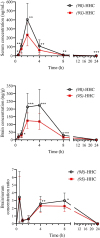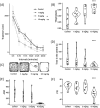Hexahydrocannabinol: pharmacokinetics, systemic toxicity, and acute behavioral effects in Wistar rats
- PMID: 40643195
- PMCID: PMC12342381
- DOI: 10.1093/ijnp/pyaf041
Hexahydrocannabinol: pharmacokinetics, systemic toxicity, and acute behavioral effects in Wistar rats
Abstract
Background: Hexahydrocannabinol (HHC) is a new psychoactive substance known for its mind-altering effects and temporary legal status. It is widely used in parts of the Europe and United Kingdom as a legal alternative to ∆9-tetrahydrocannabinol, yet little research has explored its effects and safety. This study examined how HHC is processed in the body, its toxicity, and its impact on behavior in male Wistar rats.
Methods: A 1:1 mixture of (9R)-HHC and (9S)-HHC was administered via intragastric gavage at doses of 1, 5, and 10 mg/kg. Behavioral effects were assessed using the open field test and the prepulse inhibition of acoustic startle response.
Results: Two hours after the highest dose (10 mg/kg), peak concentrations of HHC were detected in blood and brain tissue. The Organization for Economic Co-operation and Development 423 toxicity test classified HHC as a Category 4 substance, estimating a lethal dose of 1000 mg/kg. Compared to controls (administered by sunflower oil), 10 mg/kg HHC reduced movement, increased anxiety, and impaired sensory processing.
Conclusions: Overall, HHC crosses the blood-brain barrier, exhibits mild toxicity, and induces behavioral effects similar to tetrahydrocannabinol. Its dose-dependent anxiogenic properties and impact on information processing highlight the importance of the appropriate dosing in any potential therapeutic use.
Keywords: acute toxicity; behavior; hexahydrocannabinol; pharmacokinetics; rat.
© The Author(s) 2025. Published by Oxford University Press on behalf of the CINP.
Conflict of interest statement
T.P. declares to have shares in “Psyon s.r.o.,” and has founded “PSYRES—Psychedelic Research Foundation.” T.P. has shares in “Společnost pro podporu neurovědního výzkumu s.r.o.” and reports consulting fees from GH Research and CB21-Pharma outside the submitted work. T.P. is involved in Compass Pathways, MAPS, GH-Research, Ketabon clinical trials with psilocybin, MDMA, 5-MeO-DMT, ketamine, and MDMA outside the submitted work.
Figures



Similar articles
-
Prescription of Controlled Substances: Benefits and Risks.2025 Jul 6. In: StatPearls [Internet]. Treasure Island (FL): StatPearls Publishing; 2025 Jan–. 2025 Jul 6. In: StatPearls [Internet]. Treasure Island (FL): StatPearls Publishing; 2025 Jan–. PMID: 30726003 Free Books & Documents.
-
NTP Developmental and Reproductive Toxicity Technical Report on the Prenatal Development Studies of 2-((1-(4-Phenoxyphenoxy)propan-2-yl)oxy)pyridine (CASRN 95737-68-1) in Sprague Dawley (Hsd:Sprague Dawley® SD®) Rats and New Zealand White (Hra:NZW SPF) Rabbits: DART Report 07 [Internet].Research Triangle Park (NC): National Toxicology Program; 2022 Jan. Research Triangle Park (NC): National Toxicology Program; 2022 Jan. PMID: 35593777 Free Books & Documents. Review.
-
Rituximab for myasthenia gravis.Cochrane Database Syst Rev. 2025 Jul 3;7(7):CD014574. doi: 10.1002/14651858.CD014574.pub2. Cochrane Database Syst Rev. 2025. PMID: 40607605 Review.
-
Foetal haemoglobin inducers for reducing blood transfusion in non-transfusion-dependent beta-thalassaemias.Cochrane Database Syst Rev. 2023 Jan 13;1(1):CD013767. doi: 10.1002/14651858.CD013767.pub2. Cochrane Database Syst Rev. 2023. PMID: 36637054 Free PMC article.
-
Teclistamab Dosing in Responders: Modeling and Simulation Results from the MajesTEC-1 Study in Relapsed/Refractory Multiple Myeloma.Target Oncol. 2025 Jul;20(4):651-661. doi: 10.1007/s11523-025-01149-1. Epub 2025 May 7. Target Oncol. 2025. PMID: 40332715 Free PMC article. Clinical Trial.
References
-
- Qureshi MN, Kanwal F, Afridi M, Akram M. Estimation of biologically active cannabinoids in Cannabis indica by gas chromatography–mass spectrometry (GC-MS). World Appl Sci J 2012;19:918–923. 10.5829/idosi.wasj.2012.19.07.1922 - DOI
-
- Collins A, Tesfatsion T, Ramirez G, Ray K, Cruces W. Nonclinical in vitro safety assessment summary of hemp-derived (R/S)-hexahydrocannabinol ((R/S)-HHC). Cannabis Sci Technol 2022;5:23–27.
-
- Collins A, Ramirez G, Tesfatsion T, Ray KP, Caudill S, Cruces W. Synthesis and characterization of the diastereomers of HHC and H4CBD. Nat Prod Commun 2023;18:1934578X231158910. 10.1177/1934578X231158910 - DOI
-
- Adams R, Pease DC, Cain CK, Clark JH. Structure of cannabidiol. VI. Isomerization of cannabidiol to tetrahydrocannabinol, a physiologically active product. Conversion of cannabidiol to cannabinol. J Am Chem Soc 1940;62:2402–2405. 10.1021/ja01866a040 - DOI
Grants and funding
LinkOut - more resources
Full Text Sources

